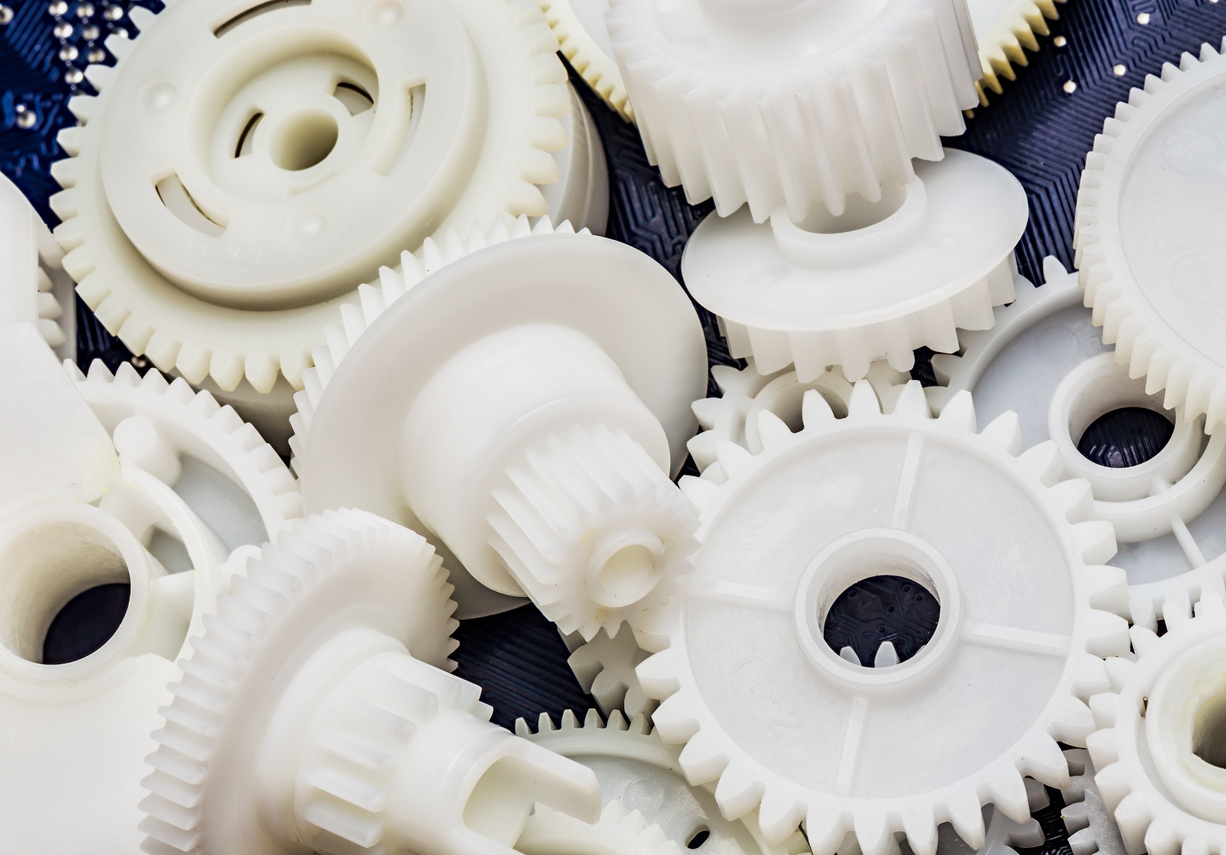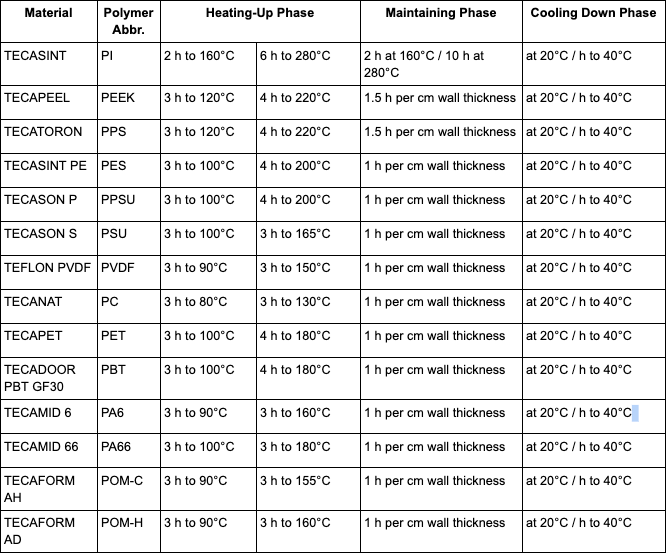When determining which plastic is most suitable for a project, engineers look at its chemical and mechanical properties. The plastic’s chemical composition and crystalline structure largely influence the material’s properties. However, the properties can be changed with a heat treatment process called annealing. While annealing is not typically performed as part of most manufacturing processes, there are times when it is necessary.
What is Plastic Annealing?
Annealing is a heat treatment process used to improve the properties of plastics by relieving internal stresses, which can be due to manufacturing processes (e.g., injection molding or machining) or environmental factors (e.g., rapid temperature changes or exposure to chemicals). If these stresses are not relieved, stress can concentrate, causing the plastic to crack; the plastic may warp or deform under load or over time; or the stressed plastic may have lower mechanical strength, chemical resistance, or dimensional stability.
Plastic annealing involves heating the plastic to a specific temperature below its glass transition temperature (Tg). Tg is the temperature at which the plastic changes from a rigid, glassy state to a rubbery state. The process involves:
- Heating—The plastic part is gradually heated to the designated annealing temperature, typically ranging from a third to half of the plastic’s melting point. Different plastics require different annealing temperatures. Annealing is generally carried out in a special recirculating air oven; however, it can also be performed in an oven with circulating nitrogen or in an oil bath. The medium may depend on the material being annealed and the size of the part. For example, Nylon will oxidize and discolor if annealed with air.
- Soaking—The plastic is held at the annealing temperature for a specific time, allowing the polymer chains to relax and relieve internal stresses. The hold time depends on the part thickness and the type of plastic.
- Cooling—The plastic is slowly cooled down to room temperature. Rapid cooling can reintroduce stress into the material, so controlled cooling is crucial.
Parameters Used for Annealing Ensinger Materials
What Materials Can Be Annealed?
Amorphous and semi-crystalline thermoplastics are candidates for annealing. They are characterized by long, chain-like molecules that can soften and rearrange upon heating.
In amorphous thermoplastics, such as polycarbonate (PC), polystyrene (PS), and polymethyl methacrylate (PMMA or Acrylic), annealing can positively impact the plastics’ properties. It doesn’t significantly impact crystallinity as they lack a defined crystalline structure. The effects of annealing on amorphous thermoplastics include:
- Stress relief— Annealing allows the entangled polymer chains to relax and move more freely, reducing internal stress and improving dimensional stability.
- Improved clarity— Stress can cause crazing and haziness in amorphous plastics. Annealing helps eliminate these issues, creating a clearer and more visually appealing product.
- Enhanced impact resistance—Annealed amorphous plastics are better able to absorb impact energy without cracking or breaking.
In semi-crystalline thermoplastics, such as polyethylene (PE), polypropylene (PP), and nylon (PA), annealing promotes crystal growth and improves the material’s properties. Annealing results in:
- Increased crystallinity—Annealing promotes the formation of ordered crystalline regions within the plastic, which increases the material’s density, stiffness, and strength.
- Improved mechanical properties—The enhanced crystallinity translates to better tensile strength, flexural strength, and impact resistance.
- Stress relief—Similar to amorphous plastics, annealing helps relieve internal stresses and improve dimensional stability.
Thermoset plastics undergo a permanent chemical change during their formation and cannot be reshaped with heat; therefore, annealing does not affect them because their polymer chains are already locked in a fixed network. Examples of thermosets include epoxy resins, silicone rubber, and Bakelite.
The specific effects of annealing on thermoplastics will vary depending on the type of plastic and the annealing process parameters (temperature, time, cooling rate). While annealing offers benefits, it’s not always necessary. The decision to anneal depends on the specific application requirements and the potential for stress buildup.
Annealing Post Molding
Post-mold annealing is done on completed products to address the internal stresses introduced during the injection molding process itself. These stresses arise due to several factors, including:
- Uneven cooling—The plastic cools faster on the outside than the inside, creating a difference in shrinkage rates and internal stress.
- Flow-induced orientation—The plastic molecules can become aligned in the direction of flow during injection, leading to stress.
Post-mold annealing is essential for parts that require high dimensional stability and must resist stress cracking during use.
Intermediate Annealing
Intermediate annealing is performed on partially processed parts before further machining. It aims to relieve stress built up during the initial stages of processing. It can also improve machinability since annealed plastic may be easier to cut, drill, or tap without cracking or chipping.
An intermediate annealing stage can be beneficial when machining critical components, particularly if narrow tolerances are required or the components have a strong tendency to warp due to their required shape. This is often the case with asymmetric components, narrowed cross sections, and those with pockets and grooves. Fiber-reinforced or filled materials are also prone to warping due to fiber orientation. Annealing can counter additional stresses from processing; for example, inappropriate speeds and feed rates that create excessive heat. It is also beneficial when your part requires the removal of a large volume of material, primarily if it is one-sided machining.
An intermediate annealing step can help to reduce these stresses and alleviate the risk of warping. It is important to ensure that the required dimensions and tolerances are observed. Before intermediate annealing, components should first be dimensionally pre-worked with an approximate safety margin, as annealing can lead to shrinkage. Following annealing, the final dimensioning of the parts should be performed. Additionally, the component should be well supported during the intermediate annealing step to avoid warping.
What Are The Benefits of Annealing?
To reiterate, annealing offers many benefits for thermoplastics. The primary benefits are:
- Improved dimensional stability—Annealing reduces warping and ensures the plastic part retains its desired shape.
- Enhanced mechanical properties—Annealing can improve the plastic’s tensile strength, flexural strength, impact resistance, and wear resistance.
- Reduced stress cracking—Annealing relieves stress, making the plastic less prone to cracking under load or environmental factors.
- Improved chemical resistance— Annealing can enhance the plastic’s resistance to chemical attack.
- Tighter tolerance capability—Annealing minimizes warping and dimensional changes in the plastic, allowing for the creation of parts that meet stricter dimensional specifications.
- Improved machinability— Annealing can make certain plastics easier to machine by reducing internal stresses that might cause them to crack or chip during cutting operations. This is particularly relevant for intermediate annealing done before machining.
- Enhanced transparency—Annealing can improve clarity by reducing stress-induced haze and crazing in amorphous plastics like acrylic (PMMA).
Trust Ensinger With Your Next Project
While annealing offers advantages like stress relief and improved strength for certain plastics, there are situations where it’s not the best course of action, such as with thin-walled components or those with metal inserts. If you’re unsure whether annealing is appropriate for your specific project, the engineers at Ensinger have the plastic expertise to ensure your injection-molded or machined product is suitable for its intended use, whether that includes annealing or not. Contact us for a quote!

